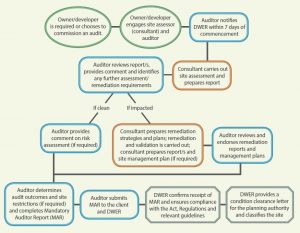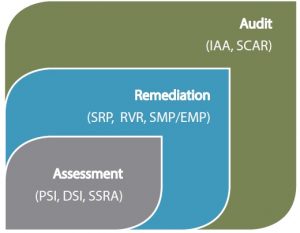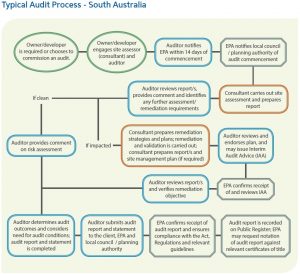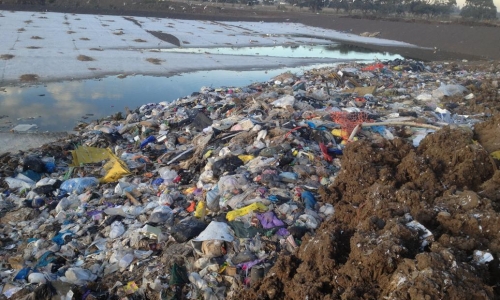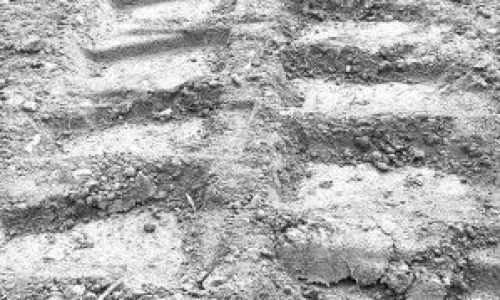AEA have some of the most experienced contaminated land auditors in Australia, supported by a trusted and diverse team of scientists and engineers.
AEA provides contaminated land (site contamination / contaminated sites) auditing in all states and territories in Australia.
The environmental audit system for contaminated land provides a mechanism for assuring planning and responsible authorities (eg. local councils), landholders and other stakeholders, that a potentially contaminated site is suitable for use. This is particularly relevant when a development occurs or if a change in land use is proposed.
Stakeholder management of potentially harmful contaminants to the environment (such as soil, groundwater, surface water and vapour) and other relevant receptors, is an important objective to consider when undertaking work on a site to ensure approval and consent is granted.
The majority of Australian states and territories have developed legislation, regulations and guidelines for the management of contaminated sites in accordance with the Commonwealth framework. This includes a requirement to undertake environmental audits on certain projects to meet the standards of the regulator (e.g. EPA) or council.
AEA’s team of experienced auditors and technical experts are able to provide independent assessment of sites to ensure the relevant conditions relating to a project’s approval have been met.
Download information on our contaminated land auditing services.
New laws came into effect on 1 July 2021. The new Act combines the old s53X and s53V audits into a single type – the scoped environmental audit. Under the new Act, before an audit can start, the scope of the audit must be established and provided to EPA. The purpose of the audit is to:
- assess the nature and extent of the risk of harm to human health or the environment. This may be from contaminated land, waste, pollution or any activity.
- recommend measures to manage the risk of harm to human health or the environment.
- make recommendations to manage the contaminated land, waste, pollution or activity.
Preliminary risk screen assessments (PRSAs) are an environmental assessment process conducted by EPA-appointed environmental auditors to determine whether there’s a need for an environmental audit and to recommend the scope for an environmental audit.
Scoped Audits
Auditors must submit a proposed scope of audit before starting it. At a minimum, the scope must include:
- the identity of the site or activity the audit covers
- the elements of the environment the audit assesses (such as land, water, air and noise)
- consideration of the standards and reference documents in the audit
- any exclusion from the audit and the reason known at the time of scoping the audit.
When audits are specifically for land-use considerations, the scope must identify the current or proposed site use. This extra requirement is for audits that support land use planning decisions and aligns with the superseded 53X audit.
At the end of the scoped audit, the auditor must prepare an environmental audit statement and an environmental audit report.
Contact Us
Contact one of our Victorian EPA-appointed auditors to ask a question about your project/operation at any stage, or to request a quote.
The site audit statement and site audit report are the outcomes of the audit. The report supports the statement, which comprises four parts. The site audit statement can be to: determine suitability of a site; or nature and extent of contamination and/or appropriateness of investigation/remediation/management plan and/or determine if land can be made suitable by implementing a remedial action/management plan.
Contact Us
Contact one of our NSW EPA-accredited auditors to ask a question about your project/operation at any stage, or to request a quote.
Land owners, occupiers and polluters are required to report all known or suspected contaminated sites to the Department of Water and Environmental Regulation (DWER). Reported sites are assessed and classified by DWER (in consultation with Department of Health), based on the risks posed to the community and environment. The classifications are:
- Report Not Substantiated
- Potentially Contaminated – Investigation Required
- Not Contaminated – Unrestricted Use
- Contaminated – Restricted Use
- Remediated – Restricted Use
- Contaminated – Remediation Required
- Decontaminated
The site auditor performs an audit of the work that the consultant performs and provides a Mandatory Auditor’s Report to DWER recommending a classification for the “source site” and any “affected” sites.
→ Contaminated Sites Auditing for Property Developers WA
Contact Us
Contact one of our WA DWER-accredited auditors to ask a question about your project/operation at any stage, or to request a quote.
A site contamination audit is carried out by an auditor. A site contamination audit (audit) is defined in section 3(1) of the Act as a review carried out by a person that:
a) examines assessments or remediation carried out by another person of known or suspected site contamination on or below the surface of a site; and
b) is for the purpose of determining any one or more of the following matters:
- the nature and extent of any site contamination present or remaining on or below the surface of the site;
- the suitability of the site for a sensitive use or another use or range of uses;
- what remediation is or remains necessary for a specified use or range of uses.
The selection of audit purposes will be determined based on the reason for the audit being carried out. An audit may be carried out or required for one or more of the following reasons:
- to satisfy the requirements of orders or voluntary agreements under the Act
- to satisfy the requirements of the planning process under the Development Act 1993
- for other purposes (ie not specifically required by legislation, such as due diligence).
→ Site Contamination Auditing for Property Developers SA
Contact Us
Contact one of our SA EPA-accredited auditors to ask a question about your project/operation at any stage, or to request a quote.
An environmental audit may be required by the NT EPA or be ordered by the Court on application of the prosecutor. An environmental audit program must be approved by the NT EPA and conducted by a qualified person. Contravention or failure to comply with the requirement of an environmental audit may be considered an offence under the Act.
An environmental audit is an evaluation of any of the following:
a) the ability of management systems to manage waste or prevent, reduce, control, rectify or clean up pollution or environmental harm resulting from pollution;
b) the extent to which actions required to be taken, or results required to be achieved, for waste management or the prevention, reduction, control, rectification or clean-up of pollution or environmental harm resulting from pollution have been taken or achieved;
c) the extent, nature and source of wastes generated by an activity, premises or process;
d) the likelihood of waste management problems or pollution resulting in environmental harm occurring and the adequacy of safeguards in place to prevent their occurrence or limit their impact on the environment;
e) the extent to which compliance with this Act, the Water Act or a code of practice has been achieved;
f) the types, amount, distribution or mobility of contaminants or waste present in the environment.
Contact Us
Contact one of our accredited auditors to ask a question about your project/operation at any stage, or to request a quote.
A contaminated land auditor is responsible for auditing the work of the suitably qualified person (SQP) by evaluating and certifying site investigation and validation reports and drafting the site management plans that are submitted for a decision on a land contamination matter.
Auditors can provide certainty on the regulatory function performed and may assist in streamlining the decision process for land contamination matters. A complex project may benefit from an approved auditor, who can oversee and evaluate the project as well as certifying it at a number of stages.
The functions of a contaminated land auditor are performed outside of the statutory decision timeframes—which are only activated once a submission has been made.
Approved auditors for contaminated land also carry out compliance assessment for development requiring a compliance permit.
Contact Us
Contact one of our Qld auditors to ask a question about your project/operation at any stage, or to request a quote.
Contact Us
Contact one of our auditors to ask a question about your project/operation at any stage, or to request a quote.
Auditors accredited under the NSW or VIC schemes are being used in the ACT and are recognised under Section 75 of the Act as suitable for the purposes of undertaking environmental audits of contaminated land.
An audit can be conducted for the purpose of determining any one or more of the following matters:
- the nature and extent of any contamination of the land;
- the nature and extent of the assessment or remediation;
- what assessment or remediation remains necessary before the land is suitable for any specified use or range of uses; and
- the comprehensiveness of a remedial action plan for contaminated land.
On completion of an audit, the auditor is required to issue a site audit statement (or certificate of environmental audit). Prior to issuing a site audit statement, the auditor must complete a site audit report which summarises the basis and rationale for the conclusions in the site audit statement.
The main purpose of an audit is to determine whether a site is suitable for a particular use or range of uses.
Contact Us
Contact one of our auditors to ask a question about your project/operation at any stage, or to request a quote.
>>> Meet our auditors
Our Projects
Our experienced auditors have a rich history of small to large scale
projects in all types of industries across the country.
Get in touch
Get in touch with one of our auditors or technical team regarding
your project or environmental audit requirements today.

